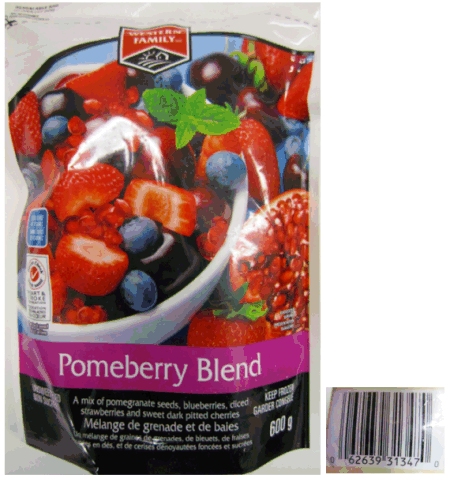State health and agriculture officials said today that six recent cases of salmonellosis in Minnesota have been linked to raw, frozen, breaded and pre-browned, stuffed chicken entrees. The implicated product is Antioch Farms brand A La Kiev raw stuffed chicken breast with a U.S. Department of Agriculture stamped c ode of P-1358. This product is sold at many different grocery store chains. Investigators from the Minnesota Department of Health (MDH) and the Minnesota Department of Agriculture (MDA) determined that six cases of Salmonella infection from August and September 2014 were due to the same strain of Salmonella Enteritidis. One person was hospitalized for their illness. “Our DNA fingerprinting found that the individuals were sickened by the same strain of Salmonella,” said Dr. Carlota Medus, epidemiologist for the Foodborne Diseases Unit at MDH. “The Minnesota Department of Agriculture collected samples of the same type of product from grocery stores and the outbreak strain of Salmonella was found in packages of this product.” There have been six outbreaks of salmonellosis in Minnesota linked to these types of products from 1998 through 2008. This is the first outbreak since improvements were made in 2008 to the labeling of these products. The current labels clearly state that the product is raw. Salmonella is sometimes present in raw chicken, which is why it is important for consumers to follow safe food-handling practices. This includes cooking all raw poultry products to an internal temperature of at least 165 degrees Fahrenheit. “The problem arises when consumers don’t realize that they are handling and preparing a raw product,” according to Dr. Carrie Rigdon, an investigator for the MDA Dairy and Food Inspection Division. MDA and MDH officials advised that consumers with these products in their freezers, if they choose to use them, should cook them thoroughly. Other important food handling practices include hand washing before and after handling raw meat, keeping raw and cooked foods separate to avoid cross-contamination, and placing cooked meat on a clean plate or platter before serving. Consumers can find more information about safe food-handling practices on the MDH website at: www.health.state.mn.us/foodsafety. Symptoms of salmonellosis include diarrhea, abdominal pain and cramps and fever. Symptoms usually begin within 12 to 72 hours after exposure, but can begin up to a week after exposure. Salmonella infections usually resolve in 5 to 7 days, but approximately 20 percent of cases require hospitalization. In rare cases, Salmonella infection can lead to death, particularly in the elderly or those with weakened immune systems.
ode of P-1358. This product is sold at many different grocery store chains. Investigators from the Minnesota Department of Health (MDH) and the Minnesota Department of Agriculture (MDA) determined that six cases of Salmonella infection from August and September 2014 were due to the same strain of Salmonella Enteritidis. One person was hospitalized for their illness. “Our DNA fingerprinting found that the individuals were sickened by the same strain of Salmonella,” said Dr. Carlota Medus, epidemiologist for the Foodborne Diseases Unit at MDH. “The Minnesota Department of Agriculture collected samples of the same type of product from grocery stores and the outbreak strain of Salmonella was found in packages of this product.” There have been six outbreaks of salmonellosis in Minnesota linked to these types of products from 1998 through 2008. This is the first outbreak since improvements were made in 2008 to the labeling of these products. The current labels clearly state that the product is raw. Salmonella is sometimes present in raw chicken, which is why it is important for consumers to follow safe food-handling practices. This includes cooking all raw poultry products to an internal temperature of at least 165 degrees Fahrenheit. “The problem arises when consumers don’t realize that they are handling and preparing a raw product,” according to Dr. Carrie Rigdon, an investigator for the MDA Dairy and Food Inspection Division. MDA and MDH officials advised that consumers with these products in their freezers, if they choose to use them, should cook them thoroughly. Other important food handling practices include hand washing before and after handling raw meat, keeping raw and cooked foods separate to avoid cross-contamination, and placing cooked meat on a clean plate or platter before serving. Consumers can find more information about safe food-handling practices on the MDH website at: www.health.state.mn.us/foodsafety. Symptoms of salmonellosis include diarrhea, abdominal pain and cramps and fever. Symptoms usually begin within 12 to 72 hours after exposure, but can begin up to a week after exposure. Salmonella infections usually resolve in 5 to 7 days, but approximately 20 percent of cases require hospitalization. In rare cases, Salmonella infection can lead to death, particularly in the elderly or those with weakened immune systems.
Direct video observation of adults and tweens cooking raw frozen chicken thingies 01.nov.09
British Food Journal, Vol 111, Issue 9, p 915-929
Sarah DeDonder, Casey J. Jacob, Brae V. Surgeoner, Benjamin Chapman, Randall Phebus, Douglas A. Powell
http://www.emeraldinsight.com/Insight/viewContentItem.do;jsessionid=6146E6AFABCC349C376B7E55A3866D4A?contentType=Article&contentId=1811820
Abstract:
Purpose – The purpose of the present study was to observe the preparation practices of both adult and young consumers using frozen, uncooked, breaded chicken products, which were previously involved in outbreaks linked to consumer mishandling. The study also sought to observe behaviors of adolescents as home food preparers. Finally, the study aimed to compare food handler behaviors with those prescribed on product labels.
Design/methodology/approach – The study sought, through video observation and self-report surveys, to determine if differences exist between consumers’ intent and actual behavior.  Findings – A survey study of consumer reactions to safe food-handling labels on raw meat and poultry products suggested that instructions for safe handling found on labels had only limited influence on consumer practices. The labels studied by these researchers were found on the packaging of chicken products examined in the current study alongside step-by-step cooking instructions. Observational techniques, as mentioned above, provide a different perception of consumer behaviors.
Originality/value – This paper finds areas that have not been studied in previous observational research and is an excellent addition to existing literature.
Findings – A survey study of consumer reactions to safe food-handling labels on raw meat and poultry products suggested that instructions for safe handling found on labels had only limited influence on consumer practices. The labels studied by these researchers were found on the packaging of chicken products examined in the current study alongside step-by-step cooking instructions. Observational techniques, as mentioned above, provide a different perception of consumer behaviors.
Originality/value – This paper finds areas that have not been studied in previous observational research and is an excellent addition to existing literature.








 Pomeberry product and an investigation is ongoing. This product has been distributed through Save-On-Foods and Overwaitea.
Pomeberry product and an investigation is ongoing. This product has been distributed through Save-On-Foods and Overwaitea.
 the refrigerator for four days."
the refrigerator for four days." glove – balled up and covered in sauce.
glove – balled up and covered in sauce.